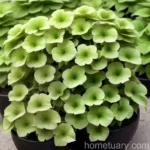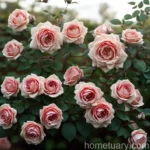Climbing Polyantha Rose (Rosa ‘Climbing Mademoiselle Cécile Brünner’)
In the world of flora, the climbing polyantha rose is a fascinating and delicate specimen, loved for its charming and majestic presence. It belongs to the rose family, scientifically known as Rosa, and its distinct variety ‘Climbing Mademoiselle Cécile Cécile Brünner’ has captivated the hearts of many gardeners and enthusiasts. In this comprehensive guide, we will dive into the world of climbing polyantha roses, exploring its key attributes, cultivation, care, and much more.
What is a Climbing Polyantha Rose?

The climbing polyantha rose, or Rosa ‘Climbing Mademoiselle Cécile Cécile Brünner,’ is a stunning and vigorous climbing rose that makes a striking addition to any garden or landscape. It is a member of the polyantha rose family, characterized by its clusters of small, double flowers that bloom abundantly throughout the growing season. This variety, in particular, is cherished for its long, flexible canes that allow it to gracefully cascade over trellises, arbors, and other garden structures, creating a mesmerizing display of delicate blooms.
Key Takeaways – Climbing Polyantha Rose (Rosa ‘Climbing Mademoiselle Cécile Cécile Brünner’)
Culture
- Hardiness Zone: Suitable for zones 6-9.
- Mature Height: Typically reaches 8-12 feet in height, but can vary based on growing conditions and pruning.
- Flowering: Produces abundant clusters of small, double flowers, known for their delicate blush pink color and sweet fragrance.
- Foliage: The foliage is a rich, glossy green, adding to the overall beauty of the plant.
- Growth Habit: Vigorous climbing habit, making it well-suited for training on trellises, fences, and other supporting structures.
Uses
- Garden Landscapes: Adds a touch of elegance and romance to garden landscapes, particularly when grown on trellises, arbors, or along fences.
- Cut Flowers: The delicate blooms make lovely cut flowers, perfect for adorning floral arrangements and bouquets.
Water
- Watering Frequency: Requires regular watering, particularly during the flowering season and in dry or hot conditions.
- Soil Moisture: Thrives in well-drained soil with consistent moisture levels.
Sunlight
- Full Sun: Flourishes in full sun conditions, with at least 6-8 hours of direct sunlight daily.
- Partial Shade: Can tolerate partial shade but may result in reduced flowering.
Fertilizer
- Balanced Fertilizer: Benefits from a balanced fertilizer application in early spring as new growth appears.
Soil
- Soil Type: Thrives in rich, loamy soil with good drainage.
- Soil pH: Prefers slightly acidic to neutral soil pH levels (pH 6.0-7.0).
Pruning
- Pruning Time: Best pruned in late winter or early spring to remove dead or weak growth and shape the plant.
- Pruning Technique: Regular pruning encourages new growth and helps maintain a tidy and robust form.
Propagation
- Propagation Methods: Can be propagated through softwood cuttings, hardwood cuttings, and layering.
Container Popularity
- Container Gardening: Can be grown in containers, particularly large and deep ones, provided adequate support and regular care.
Container Common Diseases
- Common Diseases: Susceptible to common rose diseases such as powdery mildew, black spot, and botrytis blight.
Disease Diagnosis
- Visual Inspection: Regularly inspect the foliage and stems for any signs of discoloration, spots, or unusual growth.
Common Pests
- Aphids and Spider Mites: Regularly check for these common pests and take appropriate measures for control.
Botanist’s Tips
- Support Structures: Provide sturdy and aesthetically pleasing support structures such as trellises, arches, or fences for the climbing canes.
Fun Facts
- The ‘Climbing Mademoiselle Cécile Cécile Brünner’ rose is named after the renowned rosarian, Cécile Brünner, honoring her contributions to the world of roses.
- This rose variety is known for its exceptional disease resistance, making it a favorite choice for low-maintenance gardens.
Links to External Resources
- American Rose Society – Growing Climbing Roses
- RHS – Plant Finder – Rosa ‘Climbing Mademoiselle Cécile Cécile Brünner’
Now, let’s delve deeper into the world of climbing polyantha roses and explore the intricacies of cultivating and caring for these enchanting plants.
Plant Name: “Climbing Polyantha Rose (Rosa ‘Climbing Mademoiselle Cécile Cécile Brünner’)”
In this section, we will explore the specific details of the climbing polyantha rose, focusing on its cultural requirements, uses, and care guidelines.
Climbing Polyantha Rose Cultivation
The cultivation of climbing polyantha roses requires attention to several key aspects to ensure the optimal growth and flowering of the plant. From selecting the right location to providing necessary care, each step plays a crucial role in nurturing these beautiful climbers.
Climbing Polyantha Rose Uses
The versatile uses of climbing polyantha roses make them a prized addition to garden landscapes and floral arrangements. Their elegant blooms and graceful growth habit offer endless possibilities for enhancing outdoor spaces and adorning indoor settings with freshly cut flowers.
Watering the Climbing Polyantha Rose
Proper watering is essential for the health and vitality of climbing polyantha roses. Maintaining adequate soil moisture helps support robust growth and abundant flowering, creating a picturesque display of delicate blossoms.
Sunlight Requirements for Climbing Polyantha Roses
Sunlight is a vital factor in the cultivation of climbing polyantha roses, influencing their growth, flowering, and overall vigor. Understanding their sunlight requirements is key to optimizing their performance in garden landscapes.
Fertilizing Climbing Polyantha Roses
Balanced fertilization is necessary to provide climbing polyantha roses with essential nutrients for sustained growth and prolific flowering. Selecting and applying the right fertilizers at the appropriate times contributes to the overall health and beauty of the plants.
Ideal Soil Conditions for Climbing Polyantha Roses
Creating the ideal soil environment is fundamental to the successful cultivation of climbing polyantha roses. Soil quality, composition, and pH levels all influence the plant’s ability to thrive and showcase its captivating blooms.
Pruning Climbing Polyantha Roses
Pruning is a valuable practice for shaping and rejuvenating climbing polyantha roses, promoting new growth and maintaining a tidy, attractive appearance. Understanding the principles of pruning is essential for maximizing the plant’s ornamental value and longevity.
Propagating Climbing Polyantha Roses
Exploring propagation methods for climbing polyantha roses opens up opportunities for expanding their presence in a garden or creating new plants for sharing with fellow enthusiasts. Harnessing suitable techniques enhances the propagation success and ensures healthy, vibrant offspring.
Growing Climbing Polyantha Roses in Containers
Cultivating climbing polyantha roses in containers offers a flexible and creative approach to incorporating these captivating climbers into various settings. Understanding the unique considerations for container gardening is crucial for achieving successful results.
Popularity of Climbing Polyantha Roses in Containers
The rising popularity of growing climbing polyantha roses in containers reflects the increasing interest in versatile and space-efficient gardening solutions. Their adaptability to container growth opens up new horizons for enjoying these enchanting roses in diverse urban and suburban environments.
Common Diseases of Climbing Polyantha Roses in Containers
Despite their alluring beauty, climbing polyantha roses in containers are susceptible to specific diseases that warrant careful attention and proactive management. Awareness of common diseases and their treatments is critical for safeguarding the health and vigor of container-grown roses.
Diagnosing Diseases in Climbing Polyantha Roses
Timely diagnosis of diseases in climbing polyantha roses is pivotal for implementing effective control measures and preventing potential spread. Monitoring the plants for symptoms and understanding disease patterns aids in early intervention and successful management.
Common Pests Affecting Climbing Polyantha Roses in Containers
Managing pests is an essential aspect of caring for climbing polyantha roses in containers, safeguarding the plants from potential damage and preserving their ornamental appeal. Recognizing common pests and deploying appropriate control methods is key to ensuring the well-being of container-grown roses.
Botanist’s Tips for Growing Climbing Polyantha Roses in Containers
Incorporating botanist-approved tips and strategies into the cultivation of climbing polyantha roses in containers enhances their growth, resilience, and aesthetic impact. Leveraging expert insights elevates the container gardening experience and cultivates thriving, picturesque climbers.
Fun Facts about Climbing Polyantha Roses
Delving into the fascinating world of climbing polyantha roses uncovers intriguing facts and noteworthy attributes that deepen our appreciation for these captivating plants. Discovering their remarkable history and endearing qualities adds an enriching dimension to the gardening journey.
Links to External Resources
- Royal Horticultural Society – Climbing Roses – Planting
- Gardener’s World – How to Grow Climbing Roses
As we continue our exploration of climbing polyantha roses, we unravel the intricate details of these enchanting climbers and gain valuable insights into their care and cultivation.
Climbing Polyantha Rose: In-Depth Insights
The climbing polyantha rose, Rosa ‘Climbing Mademoiselle Cécile Cécile Brünner,’ enthralls and inspires with its graceful form, delicate blooms, and rich heritage. Its distinct attributes and captivating presence make it a beloved choice for gardeners, enthusiasts, and admirers of natural beauty. Here, we will delve into in-depth insights on the cultivation, care, and appreciation of this exceptional rose variety.
Climbing Polyantha Rose: An Elemental Elegance
The elemental elegance of the climbing polyantha rose stems from its exquisite combination of form, color, and fragrance. As it weaves its way up trellises, arches, and other supports, it evokes a sense of timeless romance and natural splendor, enriching any outdoor setting with its captivating presence. This section delves into the intrinsic allure of the climbing polyantha rose, celebrating its botanical significance and horticultural appeal.
Rosa Brünner: A Legacy of Beauty
The lineage of the climbing polyantha rose, Rosa ‘Climbing Mademoiselle Cécile Cécile Brünner,’ traces back to the esteemed rosarian, Cécile Brünner, revered for her contributions to the world of roses. Her namesake cultivar carries forward a legacy of beauty and botanical distinction, enchanting generations of enthusiasts with its timeless charm and enduring resilience. Here, we pay tribute to the remarkable heritage of Rosa Brünner and its enduring impact on the realm of roses.
Cultivating Climbing Polyantha Roses: A Symphony of Care
Cultivating climbing polyantha roses embodies a symphony of care, merging essential practices with a deep appreciation for their natural splendor. From selecting the right location to nurturing their growth and tending to their needs, every step in their cultivation orchestrates a harmonious rhythm that enriches the garden landscape and touches the hearts of those who behold their ethereal beauty. Let’s embark on a journey of nurturing and cherishing these captivating climbers.
Unveiling the Charms of Climbing Polyantha Roses
The charms of climbing polyantha roses unfold in a captivating display of delicate blooms, lustrous foliage, and an enchanting fragrance that beckons to the senses. Their elegant and enduring beauty renders them as timeless symbols of love, grace, and natural abundance, weaving their intricate tales amidst the garden landscape and adorning the world with their mesmerizing allure. Unveiling their charms invites us to embrace a world of botanical fascination and horticultural wonder.
A Fragrant Tapestry: Climbing Polyantha Rose Varieties
The world of climbing polyantha roses encompasses a fragrant tapestry of varieties, each bearing its unique character, aesthetics, and contribution to the realm of roses. From the ethereal ‘Climbing Mademoiselle Cécile Cécile Brünner’ to other distinguished cultivars, the diverse array of climbing polyantha roses adds depth and dimension to garden landscapes, offering a kaleidoscope of colors, forms, and fragrances for enthusiasts to behold and enjoy.
Harmonizing with Nature: Cultivating Climbing Polyantha Roses
Cultivating climbing polyantha roses fosters a harmonious bond with nature, inviting us to participate in the timeless rhythms of growth, renewal, and natural splendor. Balancing art and science, care and appreciation, we engage in a partnership with these enchanting climbers, recognizing their intrinsic value and cherished place within the intricate web of botanical wonders that grace our world.
Links to External Resources
Rosa ‘Climbing Mademoiselle Cécile Cécile Brünner’: A Blossoming Beauty
Rosa ‘Climbing Mademoiselle Cécile Cécile Brünner’ emerges as a blossoming beauty, weaving a tale of grace, resilience, and enduring allure. Its delicate blush pink blooms, sweet fragrance, and captivating presence captivate the imagination and infuse the garden landscape with an ethereal charm that transcends seasons and spans generations. Revel in the splendor of this enchanting rose variety and immerse yourself in its mesmerizing world of botanical brilliance.
Pruning the Climbing Polyantha Rose: A Timeless Art
Pruning the climbing polyantha rose is a timeless art that melds horticultural expertise with a discerning eye for form, balance, and vitality. Shaping the plant through thoughtful and strategic pruning practices not only enhances its ornamental appeal but also rejuvenates its energy, fostering a cycle of growth, flowering, and natural resplendence. Embrace the art of pruning and unlock the full potential of these captivating climbers.
Trellises, Arches, and Beyond: Supporting Climbing Polyantha Roses
Supporting climbing polyantha roses with trellises, arches, and other structures becomes an essential element in shaping their growth, enhancing their beauty, and elevating their presence within the garden landscape. Carefully planned and executed supporting structures provide a framework for the climbers to flourish, ensuring their graceful ascent and abundant flowering for enchanting displays of natural elegance.
Climbing Polyantha Roses: A Symphony of Fragrance
The fragrance of climbing polyantha roses evokes a symphony of floral notes that imbue the air with a captivating allure, enriching outdoor spaces and infusing indoor settings with a delicate charm that lingers in the memory. Their sweet, intoxicating aroma emerges as an essential element in their botanical poetry, weaving a fragrant tapestry that elevates the senses and celebrates the art of natural perfumery.
Climbing Polyantha Roses: A Tapestry of Colors
The tapestry of colors presented by climbing polyantha roses reveals a rich and diverse palette that paints the garden landscape with a profusion of hues, tones, and shades. From delicate blush pinks to radiant whites and other captivating shades, their colorful blossoms create a captivating spectacle that celebrates the vibrancy and diversity of nature’s floral expression.
Links to External Resources
- Fine Gardening – Training Climbing Roses on Arches
- The Old Farmer’s Almanac – Rosa ‘Climbing Mademoiselle Cécile Cécile Brünner’
In Conclusion
The climbing polyantha rose, particularly the exquisite variety ‘Climbing Mademoiselle Cécile Cécile Brünner,’ stands as a testament to the timeless allure, grace, and natural splendor of roses. With its captivating blooms, vigorous climbing habit, and enduring charm, it weaves a tale of botanical brilliance and horticultural wonder that captivates the hearts and imaginations of all who encounter its captivating presence. As we embrace the world of climbing polyantha roses, may we find inspiration, joy, and a deeper connection with the inimitable beauty of nature’s floral treasures.
I hope you enjoyed this extensive guide on the “Climbing Polyantha Rose (Rosa ‘Climbing Mademoiselle Cécile Cécile Brünner’)” and found it enriching and informative. Should you have any questions or require further insights, feel free to reach out and continue exploring the wondrous realm of botanical wonders.
Happy Gardening!
Dr. Botanist
(Ph.D. in Plant Sciences)















